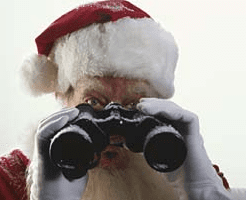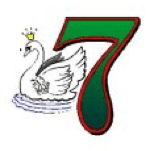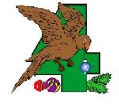 Ho, Ho, Ho. Merry Christmas everyone! With Thanksgiving day in the past, it is officially the Christmas season!
Ho, Ho, Ho. Merry Christmas everyone! With Thanksgiving day in the past, it is officially the Christmas season!
I know everyone’s feeling particularly festive this time of year and I have caught the Christmas spirit in a very situational awareness sort of way.
Surely you’ve heard of the “Twelve Days of Christmas.” -You know – Partridge in a Pear Tree and all that other stuff that no one really needs or wants, perhaps sans the five golden rings, of course. [Just don’t wear them all at once.]
And you know that Santa has good situational awareness. He’s ALWAYS capturing clues and cues. In the spirit of Christmas, I’d like to share with you my list for how to develop and maintain strong situational awareness.
Of course, like any child at Christmas, my list would be much longer than 12 items. So I encourage you to go back through the archives and read some of the more than 200 articles I’ve written here. Because… Situational Awareness Matters!
And if you’re rushed this holiday season, I’ve made it even easier for you to get the valuable lessons from the articles. Consider purchasing the Situational Awareness Matters Volumes 1 and 2 eBooks. These books contain a compilation of 80 articles, bound in book form and easy to read at your off-line leisure.
Let’s get into my wish list for the Twelve Ways to Situational Awareness.
Here is my Twelve Ways to Situational Awareness wish list. I hope you have all of them on Christmas day and every day throughout the year.
 Communications skills: This includes both listening and speaking skills. Flawed communications is a significant barrier to situational awareness. I’ve written about this in numerous articles, including some suggestions for how to improve communications. Click on the “Categories” box on the right hand side of the page and enter “Communications” to see the articles on this topic. In the early days, they used to communicate by banging drums. Now we have handheld computers. Yet we’re still plagued by communications challenges. There are many opportunities for improvement in this arena.
Communications skills: This includes both listening and speaking skills. Flawed communications is a significant barrier to situational awareness. I’ve written about this in numerous articles, including some suggestions for how to improve communications. Click on the “Categories” box on the right hand side of the page and enter “Communications” to see the articles on this topic. In the early days, they used to communicate by banging drums. Now we have handheld computers. Yet we’re still plagued by communications challenges. There are many opportunities for improvement in this arena.
Vigilance: To be vigilant is to be on-guard. Always on-guard. Your imagination isn’t good enough to think of all the ways this job can kill you. Be alert, even when it seems like things are routine. That is the mindset of a survivalist. Nero may have fiddled while Rome burned and eleven pipers may have piped for Christmas. Play whatever instrument you want. Just be sure you do it with your guard up. Always.
Avoiding judgment: The judging mind cannot learn. When you jump to conclusions about how firefighters are getting hurt and killed you miss some very important lessons about how things unfolded around them – why things made sense at the moment things went wrong. This Christmas season the lords may be leaping. But keep your feet planted firmly on the ground. No jumping to conclusions.
Ask the hard questions: When your department has a near miss or a casualty event, don’t dance around the issue. Address the issues head-on. Near miss casualty events are wonderful learning opportunities. If you’re going to do any dance, make it a safety dance, not the denial dance. The moves for the safety dance result in learning, enlightenment and change. The moves for the denial dance produce anger, resentment and blame.
Debrief: There is a lesson to learn after every incident. Even when things go well there are lessons to be learned. Milk every opportunity to learn and share. If you can’t think of one, come up with a “what-if” scenario to discuss – discuss how things might have turned out if the circumstances were just slightly different. Don’t be shy. Grab the teat and give it a squeeze.
Know your limitations: Understand and respect the limits of your conscious awareness: The average person can only capture, process, comprehend and recall 7 pieces (+/- 2) of unrelated information. Unless something happens fast to get the information on the fast track to long-term storage, it will be quickly forgotten. As you plan how to assess emergency scenes, think about the 5-7 most critical pieces of information you need to make a good decision.
Practice: To be proficient at hands-on skills, you need to practice them. A lot… Muscles learn from muscle movement. They don’t learn from verbal instructions. The Geese may be laying, but if you want to improve your safety (and your skill set) you can’t do it laying around. Get off your rumps and train.
Recipe from Hell’s Kitchen: There is a predictable pattern of events I have seen play out time and time and time again, resulting in first responder fatalities. Avoid the five C’s that make up the Recipe from Hell’s Kitchen (enter the term in the search box to find the article): Complacency ->No Consequence -> Over Confidence -> Cocky Attitude -> Catastrophe.
Adopt an attitude of safety. It makes me sick to hear people say we’re being too safe or too cautious in our approach to this job. Yes, it’s a dangerous profession, but MANY of the ways firefighters are dying are preventable – VERY preventable. Pause right now and think of four people whose lives would be forever changed if you died on the job. Be sure that the risks you take on this job are worth the potential consequences on the lives that will be forever changed if you die.
Crawl-Walk-Run: All too often we want to train on advanced skills without mastering the basic skills. I encourage you to adopt the three part Crawl-Walk-Run approach to training. Start with a slow crawl through the basic movements of an activity, discussing the how and why in detail. Then walk through the sequence of events in segments. Stopping along the way to make course corrections if needed. Then, once the first two steps are mastered. Run! Run the full evolution beginning to end. If you get it right, run it again, and again. If you don’t get it right, back up to the walk phase and make corrections in the segments. It’s as simple as 1-2-3: Crawl-Walk-Run.
Use Command Teams: Firefighting and emergency crews always work in teams of at least two. But the commanders are often left to fend for themselves – working alone in a very high-stress environment. This is a set-up for failure. Strive to ensure command runs in teams of at least two as well.
Conduct 360-degree size ups: The thorough 360-degree size-up is the foundation of incident situational awareness. It allows you to figure out what the problem is before you go throwing solutions around. It can be very helpful to find out the solution you are planning to implement isn’t going to fix the problem… before things go wrong.
_____________________________________________________

If you are interested in taking your understanding of situational awareness and high-risk decision making to a higher level, check out the Situational Awareness Matters Online Academy.
CLICK HERE for details, enrollment options and pricing.
__________________________________
Share your comments on this article in the “Leave a Reply” box below. If you want to send me incident pictures, videos or have an idea you’d like me to research and write about, contact me. I really enjoy getting feedback and supportive messages from fellow first responders. It gives me the energy to work harder for you.
Thanks,

Email: Support@RichGasaway.com
Phone: 612-548-4424
SAMatters Online Academy
Facebook Fan Page: www.facebook.com/SAMatters
Twitter: @SAMatters
LinkedIn: Rich Gasaway
Instagram: sa_matters
YouTube: SAMattersTV
iTunes: SAMatters Radio
iHeart Radio: SAMatters Radio












Thank you for this very valuable information….I wish I was in a position of leadership where I could enact change to make all of the above a reality. Someday!
Thanks for the comment. You don’t have to be in a formal position of leadership to influence change. That can happen from any level of the organization with the influence of informal leadership.
Rich,
Thanks for this great, and very pleasant to read, article.
@Prescott: A nice read froma colleague from Canada on leading from the floor can be found at: http://www.firefightingincanada.com/content/view/15712/213/
Harold,
Thanks for your support and for sharing.
Rich
Merry Christmas and thank you. GB
Thank you Greg. I appreciate your support very much!
The best of the Christmas season to you and your family.